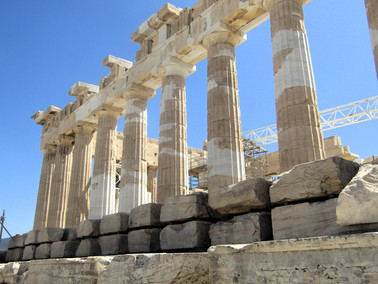It's hard to imagine how any description of Athens can start with anything other than the Acropolis, which dominates the skyline wherever you are. The Acropolis, literally meaning 'highest point in a city', is a citadel on a flat rock. A number of temples were built within the citadel, including the Parthenon, which we'll get to shortly.
Athens has no skyscrapers (a bit of a shock after Dubai); buildings are not permitted to be taller than about 30 metres in height, which is roughly seven storeys. The reasons for limiting the height? First, no one is allowed to block the view of the Parthenon; second, Athens is subject to earthquakes. The Acropolis is about 3 km due south from our hotel. We have a rooftop pool and bar on the 7th floor, and we are in one of the taller buildings in the city.
The walk to the top of the Acropolis is quite steep and rough in places, but you can take it easy, rest and admire the view as you ascend. It was pleasantly warm — 33 degrees C — with a cooling breeze.
On the slopes of the Acropolis is an old theatre, an old hospital and an old spring for water. Now when I say 'old', I mean 500 BC. Old. This is what's left of the Theatre of Dionysus. The dancers danced in the arena, whereas the stage as we know it — where the actors perform — was built of wood over the flat rocks (third photo). It started out as a sacred site dedicated to the god Dionysus (him of wine, fertility and good living) but Pericles, the great Greek politician, renovated the amphitheatre (I imagine him as a big impresario) and it became a venue for mass entertainment. Soap operas of the time by Sophocles, Aristophanes and Euripides ...
The natural environment around Athens looks exactly as I had expected: blue sky, olive trees, cypress trees, oleanders, bougainvillea. Greece has a lot of marble, so marble is used everywhere — including in the streets and pavements, which become super-slippery, but that's another story.
The track to the top of the Acropolis contains stones that have been so well polished over centuries by (literally) billions of visitors' feet that they are extremely smooth, and you have to watch your step. But then again, the Temple of Asclepius (the white remnants in the fourth photo) might just help you. Asclepius was the god of healing, and healing was achieved by prayers, sacrifices and dreaming — aided by snakes slithering around the patient. Oy! Scoff not! The snake on the rod of Asclepius remains a symbol of medicine today.
In more modern times (AD 160!) the Odeon of Herodes Atticus was built. Concerts are still performed in this space. In fact there was one last night, as you can see by the musical equipment still there. Elton John, Foo Fighters, Sting, Liza Minelli, Patti Smith and practically everyone who's anyone has performed here, including every opera singer of any note. It's the main venue for the Athens Festival each year. Our guide Sappo encouraged us to attend the next concert, but sadly we won't be in Athens on Monday. (I hadn't heard of the Greek artist who'll be performing, but that's incidental.)

But now we are at the top of the Acropolis and the gates loom in front of us. Greece has a total population of 10 million people; in 2022, around 30 million tourists visited Greece. August is a popular month, and we were a bit apprehensive about crowds on the Acropolis. We were pleasantly surprised that we weren't jostling for space.
Then we are through the gates and the Parthenon, the glorious Parthenon, looms before us. It has to be one of the world's most recognisable buildings. The sheer scale alone reminded us of Egyptian temples in Luxor and Kom Ombo. One of the group on our tour was an Egyptian architect, who enlightened me on how the Parthenon is different, i.e. it has more interior space than the Egyptian temples and fewer interior columns. Our tour guide Sappo wasn't 100% in agreement with him, so the group dynamic became, well, dynamic.
Anyhoo. The Parthenon was built around 500 BC and represents the peak of classical Greek art. It was dedicated the goddess Athena and contained both a 12 metre ivory and gold statue of the goddess and the wealth of the city. It functioned as the treasury; gold and other valuable offerings were stored in the Parthenon and melted down when the city needed coins.
The next few centuries were not quite as successful for Athens, and the temple was converted into a church and a mosque, depending on who was ruling Athens at the time. The low point was reached in the 1600s when Turkey was occupying Greece and storing gunpowder in the Parthenon. The Persians attacked Athens and bombarded the Parthenon (and the gunpowder), blowing up a large part of one side and damaging a lot more.
But wait, there's more indignity to come. In the mid 1800s Lord Elgin and other entitled foreigners swooped in to Athens, and continued the destruction by cutting up the remaining marbles and shipping their booty of Parthenon sculptures back to Britain. Almost 60% of existing Parthenon sculptures remain in the British Museum to this day. (A few are in the Louvre, too, to give the French their 'credit'.) The looted Elgin marbles are a very sore point with the Greeks.*
The remains of three smaller temples are near the Parthenon. The Erechtheion, a temple also dedicated to the goddess Athena, has six caryatids supporting the roof. Apparently these lovely ladies were each coloured differently, like a box of crayons. It's interesting that the buildings on the Acropolis, including the Parthenon, were brightly coloured in their heyday. They certainly weren't blinding white marble.
Are you still with me? I know that 2500 years of history and the whole of Greek mythology is a lot to take in. So we'll leap forward to the 2000s. Yes, AD — ooops, CE.
The very modern Museum of the Acropolis is just across the road from the Acropolis and occupies exactly the same amount of space as the Parthenon.

Every artefact that has been excavated from and around the site (and is still in Greece) is now housed in the museum. The sheer magnitude of the collection is fairly mindblowing. (It felt like being in the Tutankhamun museum in Cairo: eventually one becomes numb from overload of objects.)
We most enjoyed the second floor, which recreates exactly the marble panels along all four walls of the original Parthenon. Where there's an 'Elgin gap', the missing panel is shown and approximated — but the sheer scale of the appropriation/theft is very clear.
The two sculptures on the east and west pediments were also looted. This is what they looked like in 5 BC, and the remnants of one today.
And finally ... Athens is a city built over historic cities. Our guide Sappo said that Athens residents are terrified of renovating their houses in case anything archeological is found below, in which case they can't do anything further. This is what happened when the Museum of the Acropolis was first built. As the ground was excavated, experts discovered a whole village from 5 BC on the site.
The solution? Halt building. Excavate site. Cover up site to build museum. Uncover site and display it below the building. Simple! About 10 or15 years extra work, but hey, this is Athens. What's 10 to 15 years in the scale of 2500 years?
Thanks for staying with me. More to come.
* 'The refusal to return the Parthenon Marbles is the greatest act of cultural vandalism outside the Taliban blowing up the Banyama Buddhas.' https://neoskosmos.com/en/2022/11/11/dialogue/opinion/parthenon-sculptures-belong-in-the-acropolis-museum-not-in-london/






























































































Athens is such a fabulous city. We loved our visit there in 2019.